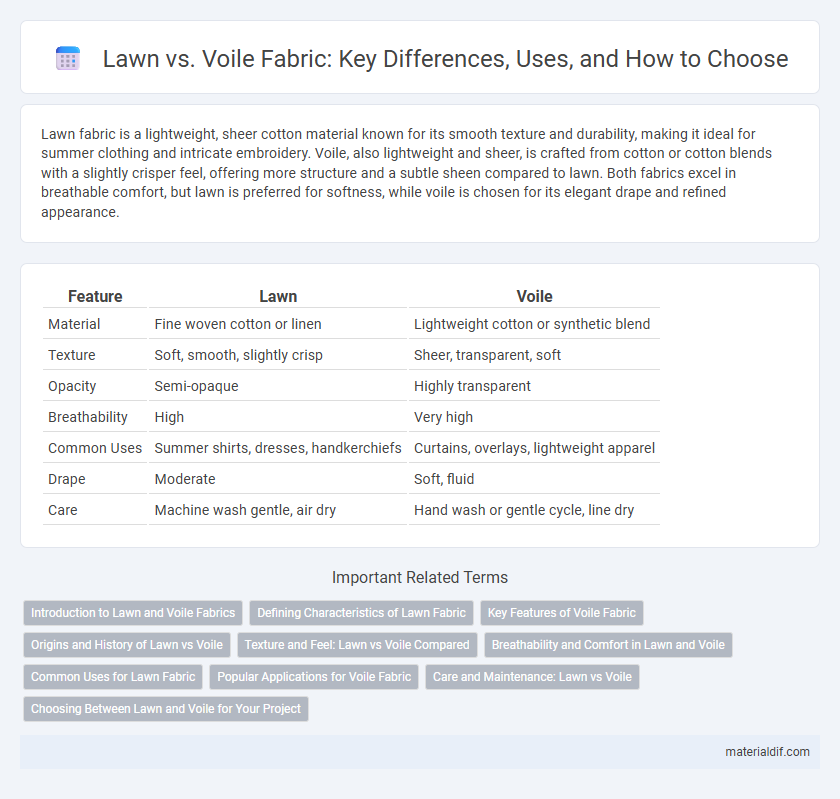Lawn fabric is a lightweight, sheer cotton material known for its smooth texture and durability, making it ideal for summer clothing and intricate embroidery. Voile, also lightweight and sheer, is crafted from cotton or cotton blends with a slightly crisper feel, offering more structure and a subtle sheen compared to lawn. Both fabrics excel in breathable comfort, but lawn is preferred for softness, while voile is chosen for its elegant drape and refined appearance.
Table of Comparison
| Feature | Lawn | Voile |
|---|---|---|
| Material | Fine woven cotton or linen | Lightweight cotton or synthetic blend |
| Texture | Soft, smooth, slightly crisp | Sheer, transparent, soft |
| Opacity | Semi-opaque | Highly transparent |
| Breathability | High | Very high |
| Common Uses | Summer shirts, dresses, handkerchiefs | Curtains, overlays, lightweight apparel |
| Drape | Moderate | Soft, fluid |
| Care | Machine wash gentle, air dry | Hand wash or gentle cycle, line dry |
Introduction to Lawn and Voile Fabrics
Lawn fabric is a lightweight, finely woven cotton known for its smooth texture and crisp finish, commonly used in summer apparel and delicate garments. Voile fabric, also lightweight but semi-sheer, features a soft, slightly crisp hand with a balanced plain weave, making it ideal for airy dresses and curtains. Both fabrics prioritize breathability and comfort, but lawn offers a sharper drape while voile provides a more fluid and translucent appearance.
Defining Characteristics of Lawn Fabric
Lawn fabric is a lightweight, finely woven cotton textile known for its crisp texture and semi-sheer appearance, making it ideal for summer garments due to its breathability and smooth hand feel. It features a high thread count that contributes to its delicate yet durable structure, providing a slightly stiffer drape compared to voile. Unlike voile, lawn has a more polished surface and a subtle sheen, emphasizing its refined finish and suitability for tailored clothing and warm-weather attire.
Key Features of Voile Fabric
Voile fabric is a lightweight, semi-sheer material made from cotton, polyester, or a blend, known for its soft, smooth texture and excellent breathability. It drapes elegantly and offers a subtle translucency, making it ideal for stylish curtains and summer garments that require a light, airy feel. Compared to lawn, voile has a more open weave and a slightly crisper hand, enhancing its versatility for both decorative and apparel uses.
Origins and History of Lawn vs Voile
Lawn fabric originated in the 18th century, named after the city of Laon in France, and is woven from fine, high-thread-count cotton, prized for its crisp texture and lightweight feel. Voile dates back to the early 19th century, derived from the French word for "veil," and traditionally made from cotton or silk, characterized by its sheer, soft, and delicate weave. While both fabrics share European origins and are popular in warm-weather clothing, lawn is known for its slightly stiffer texture, whereas voile offers a more translucent and flowing drape.
Texture and Feel: Lawn vs Voile Compared
Lawn fabric features a crisp, smooth texture with a lightweight and breathable feel, making it ideal for warm weather garments. Voile, on the other hand, has a slightly more sheer and soft finish with a delicate, fluid drape, offering a gentle touch against the skin. Compared to lawn, voile tends to be lighter and airier, providing a more translucent appearance while maintaining comfort.
Breathability and Comfort in Lawn and Voile
Lawn fabric is a fine, lightweight cotton that offers excellent breathability and moisture absorption, making it ideal for hot and humid climates. Voile, a semi-sheer cotton or cotton-blend fabric, provides a soft drape with slightly less breathability but superior comfort due to its smooth texture. Both fabrics ensure comfort, but lawn is preferred for maximum airflow and cooling, while voile offers a delicate, breathable feel with added elegance.
Common Uses for Lawn Fabric
Lawn fabric is a lightweight, finely woven cotton cloth commonly used for summer garments like shirts, blouses, and dresses due to its breathability and soft texture. It is favored in crafting curtains, handkerchiefs, and linings where a delicate, smooth finish is desired. Unlike voile, which is semi-sheer and slightly more crisp, lawn offers a denser weave that provides modest opacity while maintaining comfort in warm weather.
Popular Applications for Voile Fabric
Voile fabric is widely used in home decor, particularly for lightweight curtains and sheer drapes that allow natural light while providing privacy. It is also popular in fashion for summer clothing, including blouses, dresses, and scarves, due to its soft texture and breathable qualities. The fabric's delicate yet durable nature makes it ideal for layering and decorative overlays in both apparel and interior design.
Care and Maintenance: Lawn vs Voile
Lawn fabric requires gentle hand washing or machine washing on a delicate cycle to maintain its crisp texture and color vibrancy, while avoiding harsh detergents and bleaching agents to preserve the fine weave. Voile demands careful care through cold water washing and air drying, as its lightweight, semi-sheer fibers are prone to shrinking and delicate damage from heat exposure. Both fabrics benefit from avoiding excessive wringing and ironing at low temperatures to enhance longevity and fabric integrity.
Choosing Between Lawn and Voile for Your Project
Lawn fabric offers a lightweight, crisp texture ideal for summer garments and fine detailing, while voile provides a softer, sheer drape perfect for flowing designs and layering. Choosing between lawn and voile depends on the desired translucency and texture, with lawn being slightly more opaque and structured compared to the airy and delicate nature of voile. Consider the end use and fabric behavior under wear to ensure the best match for your project's aesthetic and comfort requirements.
Lawn vs Voile Infographic

 materialdif.com
materialdif.com